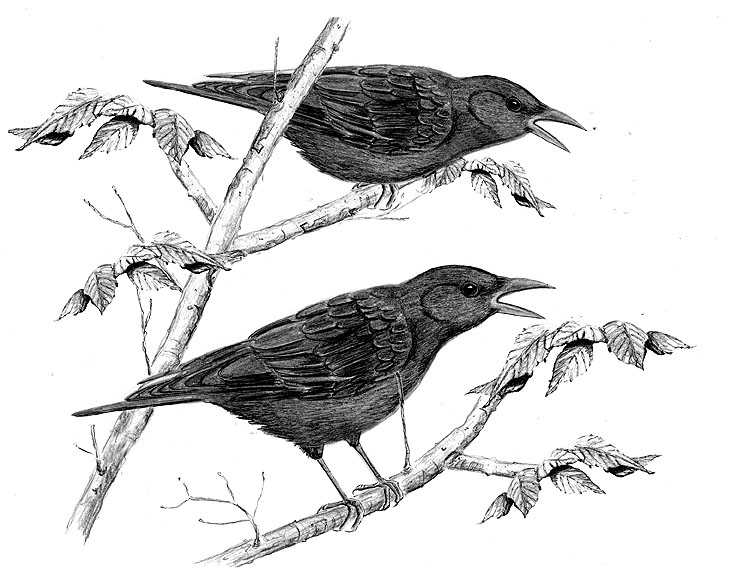
Dear Bird Folks,
Could you listen to this audio clip and tell me what bird is making this awful noise? It sounds to me like a crow in pain. It continues like that all day long, for days at a time, and it’s starting to be annoying.
– Ben, Brewster, MA
I’ll trade you, Ben,
I’ll swap the irritating bird in your neighborhood, for the ten thousand barking dogs in mine. Think about it. Swapping one item and receiving ten thousand in return is a darn good trade. How can you pass it up? I’m sure you like dogs, right? If you didn’t, you wouldn’t be allowed on Cape Cod. Plus, having a barking dog seems to be trending right now – at least it is where I live. Do you know what else is trending? Baby crows. The recording you sent me is the sweet, harmonic vocalizations of a baby crow. And when I say “sweet,” I really mean it’s the most annoying sound ever. A baby crow is the worst. It often squawks from sunrise to sunset and never takes a break. But at least there aren’t ten thousand of them…it just seems like there is.
Even though it’s late in the season, there are still baby birds around. Young songbirds, especially goldfinches, continue to chase their parents, begging for food with chirps and wing quivers. One baby songbird that does a lot more than chirp for food is the American Crow. But before we talk about the babies, I think it’s worth pointing out that surprisingly, crows are considered to be songbirds. In fact, next to ravens, crows are the largest songbirds in North America. I don’t know what criteria they use to determine what formulates a songbird, but it can’t have anything to do with singing. Even I sing better than young crows do…and that’s not a good thing.
Most “normal” songbirds build a nest and then incubate their eggs for two weeks (roughly). Two weeks after hatching, the young birds leave their nest, requiring only a few more weeks of additional care from their parents. Then, they are on their own for good. The following spring, those same baby birds will find their own mates, build their own nests and raise their own families. This is not how it works in crow world. Crows don’t breed until they are at least two years old and in many cases, not until they are four or five (or until they can drive). Instead of searching for a mate, young crows spend their early years hanging out with their parents, learning how to be better crows and helping with future broods. Crows from previous years stay together as a family group, which may contain as many as fifteen birds. These extra crows will assist the adults with nest building, food delivery and occasionally incubating eggs. This sounds like a great system, but sometimes helpers are too “helpful” and actually get in the way of the parents. Maybe that explains why crows are so noisy. They are just arguing all the time. I can see that.
As I noted earlier, the majority of our songbirds leave their nest basically two weeks after hatching. With crows that number is more like four to five weeks, since larger birds need more time to grow. Eventually though, the baby crows will take their first flight and this is when the racket really begins. The only thing young crows know about food is that if they scream loud enough, it will be delivered to them. What does a begging crow sound like? It’s not the usual crow “caw,” but more of a drawn-out “whaa,” sounding like a cross between a human baby and Edward G. Robinson. The constant pleading to be fed is monotonous, but things actually become worse when food arrives. The excited bird now becomes louder, giving a startling scream as if it’s being murdered…which some folks wished were true.
Young crows look very much like the adults, accept for a few important differences. To begin with, the kids aren’t jet black. There’s a slight amount of gray mixed into their feathers. And if you were to look into the mouth of an adult crow (you know you want to), you would see that it’s also black. Conversely, the mouth of a youngster is bright red, as if it has just eaten an Atomic Fireball, which it probably would if it could. Finally, adult crows have dark brown eyes, but their kids start off life sporting a nice pair of Paul Newman-style baby blues. (Remember Paul? If you don’t, you’ll have no clue about Edward G. Robinson.)
Because the begging calls of a young crow are droning, relentless and a bit mournful, you might get the impression the “little” bird is alone and abandoned; believe me, it’s not. The baby’s extended family keeps a constant eye on it. The other day there was a young crow yapping away in my backyard. After listening to it for a while, I decided to go out and maybe get a look at those aforementioned baby blues. The instant I stepped out the door, the surrounding trees erupted with blistering “caws” from seven or eight adult crows that had been, until then, sitting silently on babysitting duty. The wave of noise was so loud that my wife came out to see what was going on. She then gave me “the look,” indicating that it was my fault. In her mind, everything is my fault…and it usually is.
I agree with you, Ben. Young crows can be a bit annoying, but not to worry, as they mature their begging calls will diminish. It’s too bad I can’t say the same thing about the barking dogs in my neighborhood. Although I was just kidding when I said there are ten thousand of them. There’s way more than that.